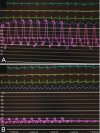Diagnosis and management of pulmonary hypertension associated with left ventricular diastolic dysfunction
- PMID: 22837857
- PMCID: PMC3401870
- DOI: 10.4103/2045-8932.97598
Diagnosis and management of pulmonary hypertension associated with left ventricular diastolic dysfunction
Abstract
Pulmonary hypertension (PH) is commonly seen in patients who present with left ventricular diastolic dysfunction (LVDD) and is considered a marker of poor prognosis. While PH in this setting is thought to result from pulmonary venous congestion, there is a subset of patients in which pulmonary pressures fail to improve with appropriate management of diastolic heart failure and go on to develop a clinical picture similar to that of patients with pulmonary arterial hypertension (PAH). Despite the utility of Doppler echocardiography and exercise testing in the initial evaluation of patients with suspected PH-LVDD, the diagnosis can only be confirmed using right heart catheterization. Management of PH-LVDD centers on both optimizing fluid management and afterload reduction to reducing left ventricular diastolic pressures and also increase pulmonary venous return. To date, there is no clear evidence that addition of PH-specific drugs can improve clinical outcomes, and their use should only be considered in the setting of clinical trials. In conclusion, PH-LVDD remains a challenging clinical entity that complicates the management of left ventricular dysfunction and significantly contributes to its morbidity and mortality. Determination of the optimal diagnostic and treatment strategies for this form of PH should be the goal of future studies.
Keywords: congestive heart failure; echocardiography; hemodynamics; pulmonary hypertension; therapeutics.
Conflict of interest statement
Figures



References
-
- Oudiz RJ. Secondary Pulmonary Hypertension. Curr Treat Options Cardiovasc Med. 2001;3:115–24. - PubMed
-
- Hoeper MM. Definition, classification, and epidemiology of pulmonary arterial hypertension. Semin Respir Crit Care Med. 2009;30:369–75. - PubMed
-
- McLaughlin VV, Archer SL, Badesch DB, Barst RJ, Farber HW, Lindner JR, et al. ACCF/AHA 2009 expert consensus document on pulmonary hypertension a report of the American College of Cardiology Foundation Task Force on Expert Consensus Documents and the American Heart Association developed in collaboration with the American College of Chest Physicians; American Thoracic Society, Inc.; and the Pulmonary Hypertension Association. J Am Coll Cardiol. 2009;53:1573–619. - PubMed
-
- Shammas RL, Khan NU, Nekkanti R, Movahed A. Diastolic heart failure and left ventricular diastolic dysfunction: What we know, and what we don’t know! Int J Cardiol. 2007;115:284–92. - PubMed
-
- Garg R, Packer M, Pitt B, Yusuf S. Heart failure in the 1990s: evolution of a major public health problem in cardiovascular medicine. J Am Coll Cardiol. 1993;22:3A–5A. - PubMed
LinkOut - more resources
Full Text Sources
Other Literature Sources

